CHCMHS005 Knowledge Assessment: Services for Coexisting Issues
VerifiedAdded on 2023/01/12
|24
|6760
|67
Homework Assignment
AI Summary
This document presents a completed knowledge assessment for the CHCMHS005 unit, focusing on providing services to people with coexisting mental health and alcohol and other drugs (AOD) issues. The assessment covers various aspects, including defining co-morbidity and dual diagnosis, identifying signs and symptoms of AOD problems, and analyzing consumer profiles to determine mental health or AOD issues. It explores the importance of holistic care, different treatment models for dually diagnosed individuals, and evidence-based best practices. The assessment also addresses services and support options for consumers, common characteristics of consumers with mental illness and/or AOD abuse, and the impact of these issues on mainstream society. Furthermore, it examines readiness assessments, the necessity of consulting with specialist services, and the symptoms associated with various substances. The document also includes discussions on models of intervention, strategies for building effective working relationships, the aim of interagency collaboration, and the importance of discussing current services and supports with planning.
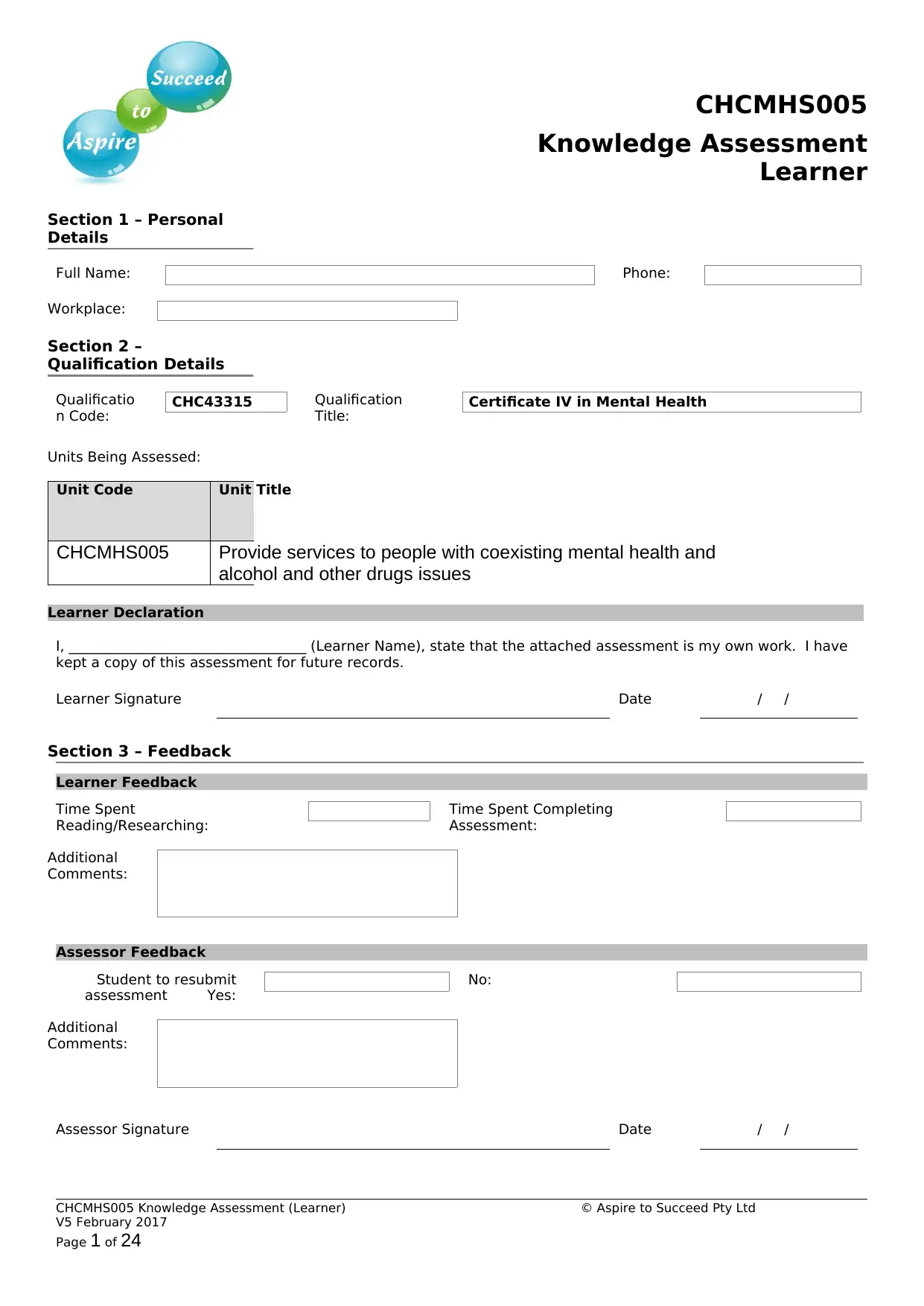
CHCMHS005
Knowledge Assessment
Learner
Section 1 – Personal
Details
Full Name: Phone:
Workplace:
Section 2 –
Qualification Details
Qualificatio
n Code:
CHC43315 Qualification
Title:
Certificate IV in Mental Health
Units Being Assessed:
Unit Code Unit Title
CHCMHS005 Provide services to people with coexisting mental health and
alcohol and other drugs issues
Learner Declaration
I, __________________________________ (Learner Name), state that the attached assessment is my own work. I have
kept a copy of this assessment for future records.
Learner Signature Date / /
Section 3 – Feedback
Learner Feedback
Time Spent
Reading/Researching:
Time Spent Completing
Assessment:
Additional
Comments:
Assessor Feedback
Student to resubmit
assessment Yes:
No:
Additional
Comments:
Assessor Signature Date / /
CHCMHS005 Knowledge Assessment (Learner) © Aspire to Succeed Pty Ltd
V5 February 2017
Page 1 of 24
Knowledge Assessment
Learner
Section 1 – Personal
Details
Full Name: Phone:
Workplace:
Section 2 –
Qualification Details
Qualificatio
n Code:
CHC43315 Qualification
Title:
Certificate IV in Mental Health
Units Being Assessed:
Unit Code Unit Title
CHCMHS005 Provide services to people with coexisting mental health and
alcohol and other drugs issues
Learner Declaration
I, __________________________________ (Learner Name), state that the attached assessment is my own work. I have
kept a copy of this assessment for future records.
Learner Signature Date / /
Section 3 – Feedback
Learner Feedback
Time Spent
Reading/Researching:
Time Spent Completing
Assessment:
Additional
Comments:
Assessor Feedback
Student to resubmit
assessment Yes:
No:
Additional
Comments:
Assessor Signature Date / /
CHCMHS005 Knowledge Assessment (Learner) © Aspire to Succeed Pty Ltd
V5 February 2017
Page 1 of 24
Paraphrase This Document
Need a fresh take? Get an instant paraphrase of this document with our AI Paraphraser
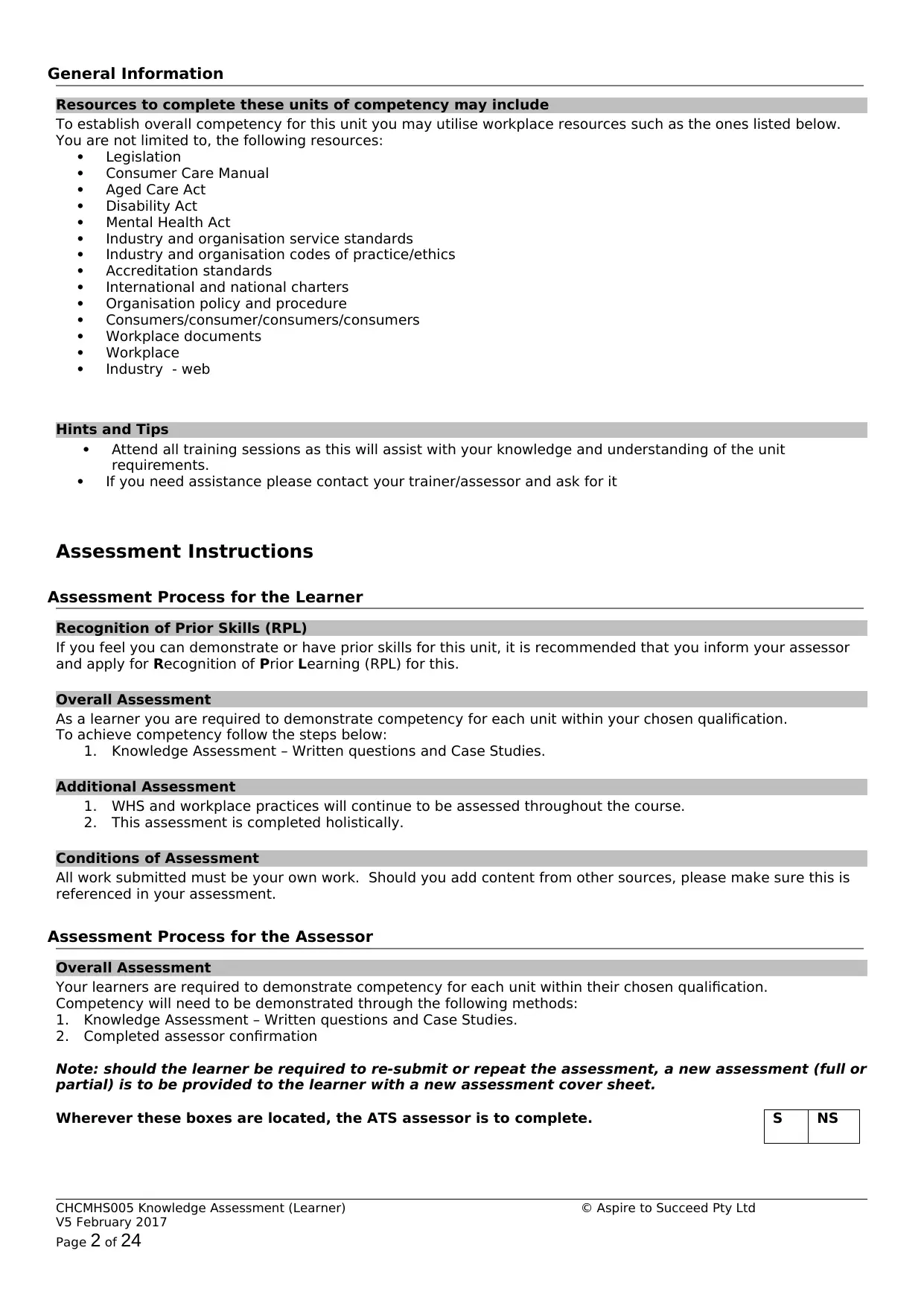
General Information
Resources to complete these units of competency may include
To establish overall competency for this unit you may utilise workplace resources such as the ones listed below.
You are not limited to, the following resources:
Legislation
Consumer Care Manual
Aged Care Act
Disability Act
Mental Health Act
Industry and organisation service standards
Industry and organisation codes of practice/ethics
Accreditation standards
International and national charters
Organisation policy and procedure
Consumers/consumer/consumers/consumers
Workplace documents
Workplace
Industry - web
Hints and Tips
Attend all training sessions as this will assist with your knowledge and understanding of the unit
requirements.
If you need assistance please contact your trainer/assessor and ask for it
Assessment Instructions
Assessment Process for the Learner
Recognition of Prior Skills (RPL)
If you feel you can demonstrate or have prior skills for this unit, it is recommended that you inform your assessor
and apply for Recognition of Prior Learning (RPL) for this.
Overall Assessment
As a learner you are required to demonstrate competency for each unit within your chosen qualification.
To achieve competency follow the steps below:
1. Knowledge Assessment – Written questions and Case Studies.
Additional Assessment
1. WHS and workplace practices will continue to be assessed throughout the course.
2. This assessment is completed holistically.
Conditions of Assessment
All work submitted must be your own work. Should you add content from other sources, please make sure this is
referenced in your assessment.
Assessment Process for the Assessor
Overall Assessment
Your learners are required to demonstrate competency for each unit within their chosen qualification.
Competency will need to be demonstrated through the following methods:
1. Knowledge Assessment – Written questions and Case Studies.
2. Completed assessor confirmation
Note: should the learner be required to re-submit or repeat the assessment, a new assessment (full or
partial) is to be provided to the learner with a new assessment cover sheet.
Wherever these boxes are located, the ATS assessor is to complete. S NS
CHCMHS005 Knowledge Assessment (Learner) © Aspire to Succeed Pty Ltd
V5 February 2017
Page 2 of 24
Resources to complete these units of competency may include
To establish overall competency for this unit you may utilise workplace resources such as the ones listed below.
You are not limited to, the following resources:
Legislation
Consumer Care Manual
Aged Care Act
Disability Act
Mental Health Act
Industry and organisation service standards
Industry and organisation codes of practice/ethics
Accreditation standards
International and national charters
Organisation policy and procedure
Consumers/consumer/consumers/consumers
Workplace documents
Workplace
Industry - web
Hints and Tips
Attend all training sessions as this will assist with your knowledge and understanding of the unit
requirements.
If you need assistance please contact your trainer/assessor and ask for it
Assessment Instructions
Assessment Process for the Learner
Recognition of Prior Skills (RPL)
If you feel you can demonstrate or have prior skills for this unit, it is recommended that you inform your assessor
and apply for Recognition of Prior Learning (RPL) for this.
Overall Assessment
As a learner you are required to demonstrate competency for each unit within your chosen qualification.
To achieve competency follow the steps below:
1. Knowledge Assessment – Written questions and Case Studies.
Additional Assessment
1. WHS and workplace practices will continue to be assessed throughout the course.
2. This assessment is completed holistically.
Conditions of Assessment
All work submitted must be your own work. Should you add content from other sources, please make sure this is
referenced in your assessment.
Assessment Process for the Assessor
Overall Assessment
Your learners are required to demonstrate competency for each unit within their chosen qualification.
Competency will need to be demonstrated through the following methods:
1. Knowledge Assessment – Written questions and Case Studies.
2. Completed assessor confirmation
Note: should the learner be required to re-submit or repeat the assessment, a new assessment (full or
partial) is to be provided to the learner with a new assessment cover sheet.
Wherever these boxes are located, the ATS assessor is to complete. S NS
CHCMHS005 Knowledge Assessment (Learner) © Aspire to Succeed Pty Ltd
V5 February 2017
Page 2 of 24
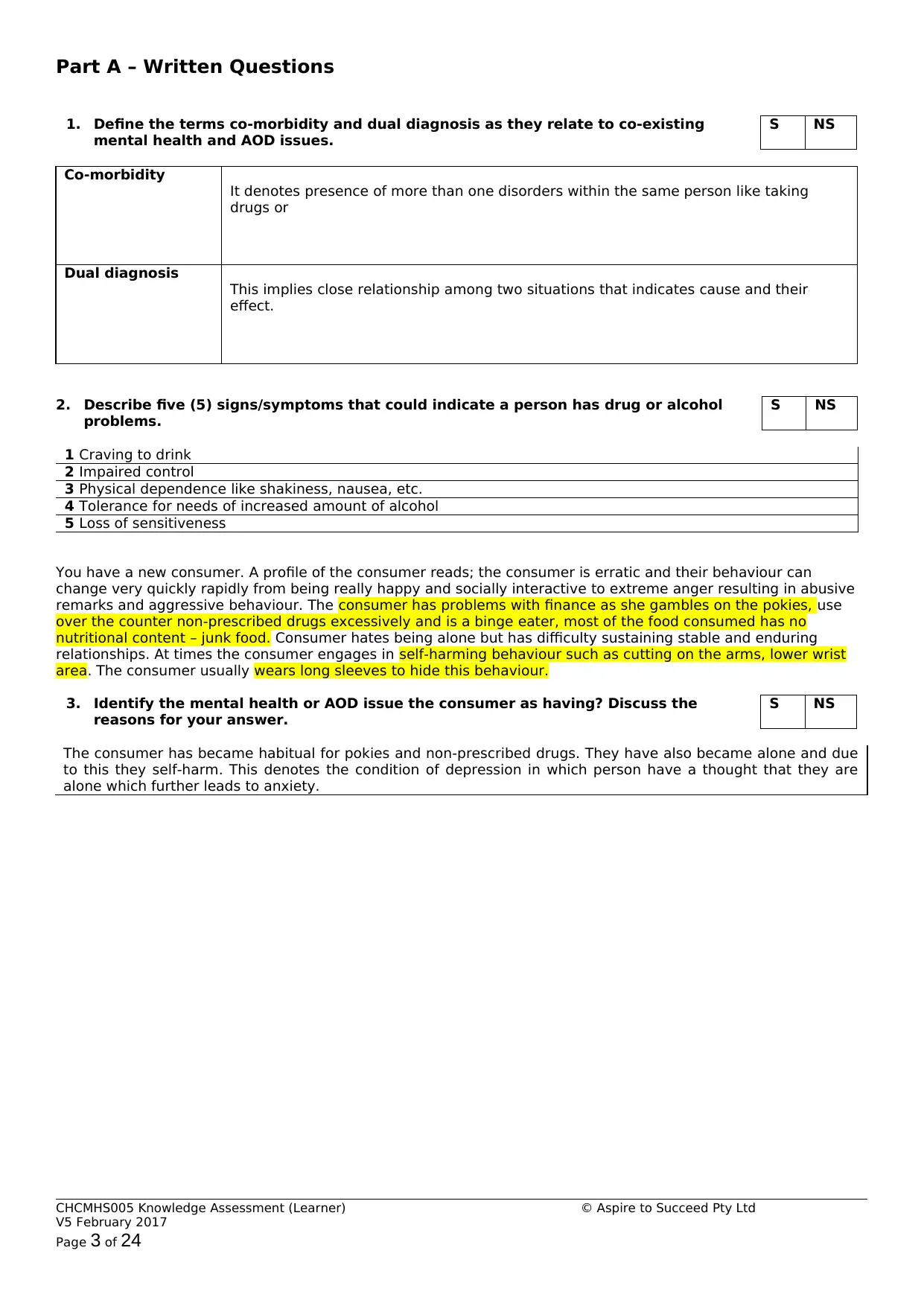
Part A – Written Questions
1. Define the terms co-morbidity and dual diagnosis as they relate to co-existing
mental health and AOD issues.
S NS
Co-morbidity
It denotes presence of more than one disorders within the same person like taking
drugs or
Dual diagnosis
This implies close relationship among two situations that indicates cause and their
effect.
2. Describe five (5) signs/symptoms that could indicate a person has drug or alcohol
problems.
S NS
1 Craving to drink
2 Impaired control
3 Physical dependence like shakiness, nausea, etc.
4 Tolerance for needs of increased amount of alcohol
5 Loss of sensitiveness
You have a new consumer. A profile of the consumer reads; the consumer is erratic and their behaviour can
change very quickly rapidly from being really happy and socially interactive to extreme anger resulting in abusive
remarks and aggressive behaviour. The consumer has problems with finance as she gambles on the pokies, use
over the counter non-prescribed drugs excessively and is a binge eater, most of the food consumed has no
nutritional content – junk food. Consumer hates being alone but has difficulty sustaining stable and enduring
relationships. At times the consumer engages in self-harming behaviour such as cutting on the arms, lower wrist
area. The consumer usually wears long sleeves to hide this behaviour.
3. Identify the mental health or AOD issue the consumer as having? Discuss the
reasons for your answer.
S NS
The consumer has became habitual for pokies and non-prescribed drugs. They have also became alone and due
to this they self-harm. This denotes the condition of depression in which person have a thought that they are
alone which further leads to anxiety.
CHCMHS005 Knowledge Assessment (Learner) © Aspire to Succeed Pty Ltd
V5 February 2017
Page 3 of 24
1. Define the terms co-morbidity and dual diagnosis as they relate to co-existing
mental health and AOD issues.
S NS
Co-morbidity
It denotes presence of more than one disorders within the same person like taking
drugs or
Dual diagnosis
This implies close relationship among two situations that indicates cause and their
effect.
2. Describe five (5) signs/symptoms that could indicate a person has drug or alcohol
problems.
S NS
1 Craving to drink
2 Impaired control
3 Physical dependence like shakiness, nausea, etc.
4 Tolerance for needs of increased amount of alcohol
5 Loss of sensitiveness
You have a new consumer. A profile of the consumer reads; the consumer is erratic and their behaviour can
change very quickly rapidly from being really happy and socially interactive to extreme anger resulting in abusive
remarks and aggressive behaviour. The consumer has problems with finance as she gambles on the pokies, use
over the counter non-prescribed drugs excessively and is a binge eater, most of the food consumed has no
nutritional content – junk food. Consumer hates being alone but has difficulty sustaining stable and enduring
relationships. At times the consumer engages in self-harming behaviour such as cutting on the arms, lower wrist
area. The consumer usually wears long sleeves to hide this behaviour.
3. Identify the mental health or AOD issue the consumer as having? Discuss the
reasons for your answer.
S NS
The consumer has became habitual for pokies and non-prescribed drugs. They have also became alone and due
to this they self-harm. This denotes the condition of depression in which person have a thought that they are
alone which further leads to anxiety.
CHCMHS005 Knowledge Assessment (Learner) © Aspire to Succeed Pty Ltd
V5 February 2017
Page 3 of 24
⊘ This is a preview!⊘
Do you want full access?
Subscribe today to unlock all pages.

Trusted by 1+ million students worldwide
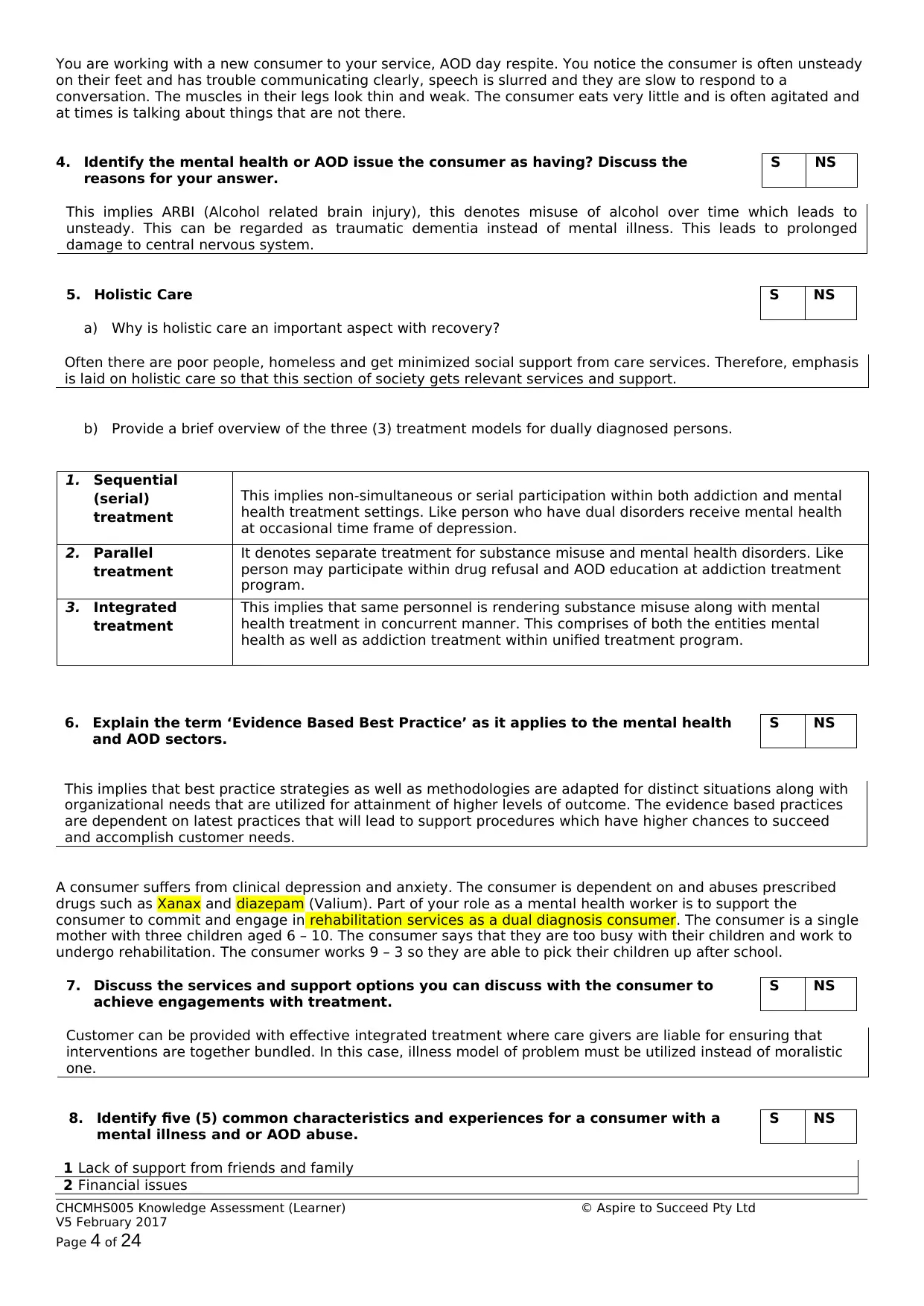
You are working with a new consumer to your service, AOD day respite. You notice the consumer is often unsteady
on their feet and has trouble communicating clearly, speech is slurred and they are slow to respond to a
conversation. The muscles in their legs look thin and weak. The consumer eats very little and is often agitated and
at times is talking about things that are not there.
4. Identify the mental health or AOD issue the consumer as having? Discuss the
reasons for your answer.
S NS
This implies ARBI (Alcohol related brain injury), this denotes misuse of alcohol over time which leads to
unsteady. This can be regarded as traumatic dementia instead of mental illness. This leads to prolonged
damage to central nervous system.
5. Holistic Care S NS
a) Why is holistic care an important aspect with recovery?
Often there are poor people, homeless and get minimized social support from care services. Therefore, emphasis
is laid on holistic care so that this section of society gets relevant services and support.
b) Provide a brief overview of the three (3) treatment models for dually diagnosed persons.
1. Sequential
(serial)
treatment
This implies non-simultaneous or serial participation within both addiction and mental
health treatment settings. Like person who have dual disorders receive mental health
at occasional time frame of depression.
2. Parallel
treatment
It denotes separate treatment for substance misuse and mental health disorders. Like
person may participate within drug refusal and AOD education at addiction treatment
program.
3. Integrated
treatment
This implies that same personnel is rendering substance misuse along with mental
health treatment in concurrent manner. This comprises of both the entities mental
health as well as addiction treatment within unified treatment program.
6. Explain the term ‘Evidence Based Best Practice’ as it applies to the mental health
and AOD sectors.
S NS
This implies that best practice strategies as well as methodologies are adapted for distinct situations along with
organizational needs that are utilized for attainment of higher levels of outcome. The evidence based practices
are dependent on latest practices that will lead to support procedures which have higher chances to succeed
and accomplish customer needs.
A consumer suffers from clinical depression and anxiety. The consumer is dependent on and abuses prescribed
drugs such as Xanax and diazepam (Valium). Part of your role as a mental health worker is to support the
consumer to commit and engage in rehabilitation services as a dual diagnosis consumer. The consumer is a single
mother with three children aged 6 – 10. The consumer says that they are too busy with their children and work to
undergo rehabilitation. The consumer works 9 – 3 so they are able to pick their children up after school.
7. Discuss the services and support options you can discuss with the consumer to
achieve engagements with treatment.
S NS
Customer can be provided with effective integrated treatment where care givers are liable for ensuring that
interventions are together bundled. In this case, illness model of problem must be utilized instead of moralistic
one.
8. Identify five (5) common characteristics and experiences for a consumer with a
mental illness and or AOD abuse.
S NS
1 Lack of support from friends and family
2 Financial issues
CHCMHS005 Knowledge Assessment (Learner) © Aspire to Succeed Pty Ltd
V5 February 2017
Page 4 of 24
on their feet and has trouble communicating clearly, speech is slurred and they are slow to respond to a
conversation. The muscles in their legs look thin and weak. The consumer eats very little and is often agitated and
at times is talking about things that are not there.
4. Identify the mental health or AOD issue the consumer as having? Discuss the
reasons for your answer.
S NS
This implies ARBI (Alcohol related brain injury), this denotes misuse of alcohol over time which leads to
unsteady. This can be regarded as traumatic dementia instead of mental illness. This leads to prolonged
damage to central nervous system.
5. Holistic Care S NS
a) Why is holistic care an important aspect with recovery?
Often there are poor people, homeless and get minimized social support from care services. Therefore, emphasis
is laid on holistic care so that this section of society gets relevant services and support.
b) Provide a brief overview of the three (3) treatment models for dually diagnosed persons.
1. Sequential
(serial)
treatment
This implies non-simultaneous or serial participation within both addiction and mental
health treatment settings. Like person who have dual disorders receive mental health
at occasional time frame of depression.
2. Parallel
treatment
It denotes separate treatment for substance misuse and mental health disorders. Like
person may participate within drug refusal and AOD education at addiction treatment
program.
3. Integrated
treatment
This implies that same personnel is rendering substance misuse along with mental
health treatment in concurrent manner. This comprises of both the entities mental
health as well as addiction treatment within unified treatment program.
6. Explain the term ‘Evidence Based Best Practice’ as it applies to the mental health
and AOD sectors.
S NS
This implies that best practice strategies as well as methodologies are adapted for distinct situations along with
organizational needs that are utilized for attainment of higher levels of outcome. The evidence based practices
are dependent on latest practices that will lead to support procedures which have higher chances to succeed
and accomplish customer needs.
A consumer suffers from clinical depression and anxiety. The consumer is dependent on and abuses prescribed
drugs such as Xanax and diazepam (Valium). Part of your role as a mental health worker is to support the
consumer to commit and engage in rehabilitation services as a dual diagnosis consumer. The consumer is a single
mother with three children aged 6 – 10. The consumer says that they are too busy with their children and work to
undergo rehabilitation. The consumer works 9 – 3 so they are able to pick their children up after school.
7. Discuss the services and support options you can discuss with the consumer to
achieve engagements with treatment.
S NS
Customer can be provided with effective integrated treatment where care givers are liable for ensuring that
interventions are together bundled. In this case, illness model of problem must be utilized instead of moralistic
one.
8. Identify five (5) common characteristics and experiences for a consumer with a
mental illness and or AOD abuse.
S NS
1 Lack of support from friends and family
2 Financial issues
CHCMHS005 Knowledge Assessment (Learner) © Aspire to Succeed Pty Ltd
V5 February 2017
Page 4 of 24
Paraphrase This Document
Need a fresh take? Get an instant paraphrase of this document with our AI Paraphraser
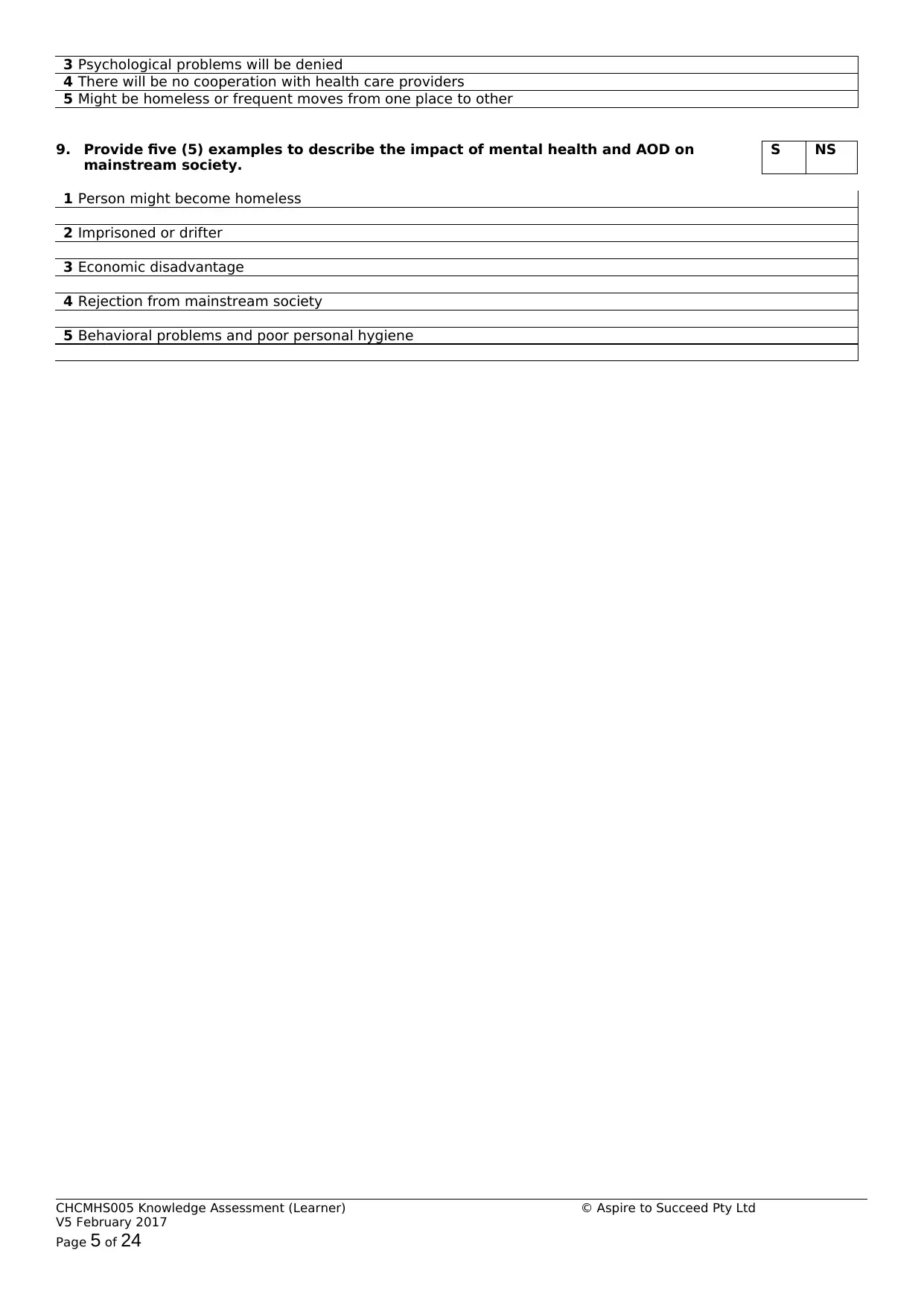
3 Psychological problems will be denied
4 There will be no cooperation with health care providers
5 Might be homeless or frequent moves from one place to other
9. Provide five (5) examples to describe the impact of mental health and AOD on
mainstream society.
S NS
1 Person might become homeless
2 Imprisoned or drifter
3 Economic disadvantage
4 Rejection from mainstream society
5 Behavioral problems and poor personal hygiene
CHCMHS005 Knowledge Assessment (Learner) © Aspire to Succeed Pty Ltd
V5 February 2017
Page 5 of 24
4 There will be no cooperation with health care providers
5 Might be homeless or frequent moves from one place to other
9. Provide five (5) examples to describe the impact of mental health and AOD on
mainstream society.
S NS
1 Person might become homeless
2 Imprisoned or drifter
3 Economic disadvantage
4 Rejection from mainstream society
5 Behavioral problems and poor personal hygiene
CHCMHS005 Knowledge Assessment (Learner) © Aspire to Succeed Pty Ltd
V5 February 2017
Page 5 of 24
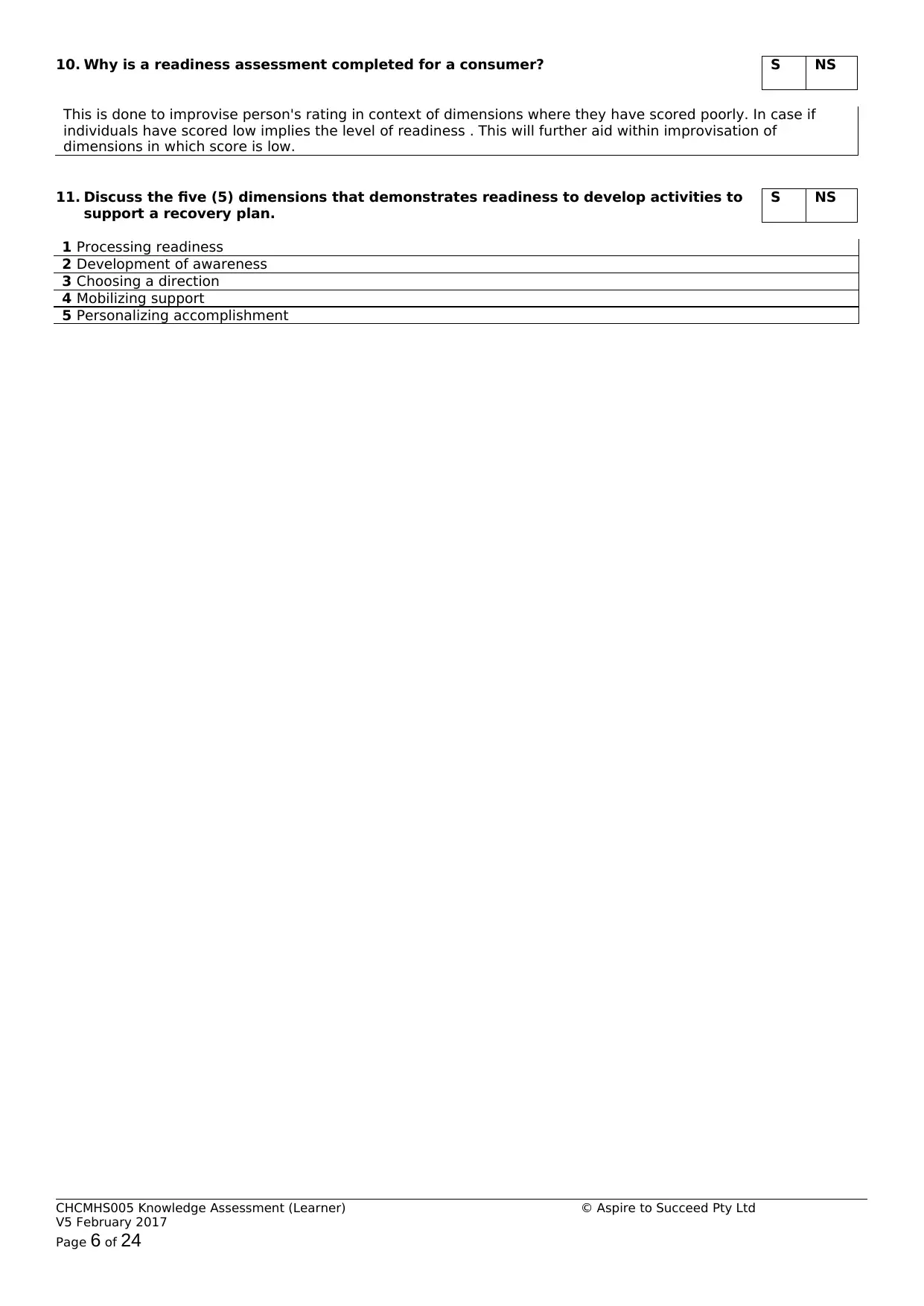
10. Why is a readiness assessment completed for a consumer? S NS
This is done to improvise person's rating in context of dimensions where they have scored poorly. In case if
individuals have scored low implies the level of readiness . This will further aid within improvisation of
dimensions in which score is low.
11. Discuss the five (5) dimensions that demonstrates readiness to develop activities to
support a recovery plan.
S NS
1 Processing readiness
2 Development of awareness
3 Choosing a direction
4 Mobilizing support
5 Personalizing accomplishment
CHCMHS005 Knowledge Assessment (Learner) © Aspire to Succeed Pty Ltd
V5 February 2017
Page 6 of 24
This is done to improvise person's rating in context of dimensions where they have scored poorly. In case if
individuals have scored low implies the level of readiness . This will further aid within improvisation of
dimensions in which score is low.
11. Discuss the five (5) dimensions that demonstrates readiness to develop activities to
support a recovery plan.
S NS
1 Processing readiness
2 Development of awareness
3 Choosing a direction
4 Mobilizing support
5 Personalizing accomplishment
CHCMHS005 Knowledge Assessment (Learner) © Aspire to Succeed Pty Ltd
V5 February 2017
Page 6 of 24
⊘ This is a preview!⊘
Do you want full access?
Subscribe today to unlock all pages.

Trusted by 1+ million students worldwide

12. Why is it necessary for a Mental Health and AOD service providers to research and
consult with specialist services?
S NS
Each individual have different immunity system which means that consumption of alcohol will also have a
different impact on their health. Thus, it is necessary that depending upon the problems faced by them they
must opt for adequate specialist services in order top avoid negative impact.
13. Referring to the substance listed in Column 1, discuss the symptoms associated with
the use of the substance.
S NS
Substance Symptoms
Alcohol Dampens the sensory and motor centers, nervous system depressant will inhibit
functions of brain.
Cannabis
Hallucinogenic impacts, lung damage, impact on memory and ability to learn
Opioids
Infertility, coma, low sex drive and coma
Amphetamines
High blood pressure, mood swings, depression, seizures and anxiety
Ecstasy
Depression and memory problems
Methamphetamine
Insomnia, anxiety, mood disturbance and confusion
14. Discuss the aim and purpose of the models of intervention to help people with
mental health and AOD problems.
S NS
Model of intervention Aims and purpose
Crisis intervention
Aim: To minimize intensity of individual's mental, behavioral, physical and
emotional reactions to crisis.
Purpose: To assists individuals to get back to levels of functioning before any
crisis
Harm minimisation Aim: To find achievable and immediate goals for reduction of harm that comprises
of availability of options to their users
Purpose: The purpose is reduce the harm that is caused by drugs
Brief or early
intervention It aims at providing intervention strategies for all concerned parties in context of
what they have to do and what to say.
The rationale is to bring friends and family together by educating them
Psychosocial
interventions Aim is to identify efficacious psychosis ail interventions for reductions of substance
use among population.
The purpose is to assess the dependency of consumers.
Detoxification
intervention
Aim: This denote the process by which individuals are withdrawn from any kind of
effects caused by psychoactive substances
Purpose: To compute the withdrawal syndrome without taking into consideration
intoxication
15. Describe five (5) strategies to build effective working relationships with a consumer. S NS
1 Planning and monitoring them
2 Self appraisal
3 Self awareness
4 Building up trust
5 Open discussion in context of ways in which services will assist them
CHCMHS005 Knowledge Assessment (Learner) © Aspire to Succeed Pty Ltd
V5 February 2017
Page 7 of 24
consult with specialist services?
S NS
Each individual have different immunity system which means that consumption of alcohol will also have a
different impact on their health. Thus, it is necessary that depending upon the problems faced by them they
must opt for adequate specialist services in order top avoid negative impact.
13. Referring to the substance listed in Column 1, discuss the symptoms associated with
the use of the substance.
S NS
Substance Symptoms
Alcohol Dampens the sensory and motor centers, nervous system depressant will inhibit
functions of brain.
Cannabis
Hallucinogenic impacts, lung damage, impact on memory and ability to learn
Opioids
Infertility, coma, low sex drive and coma
Amphetamines
High blood pressure, mood swings, depression, seizures and anxiety
Ecstasy
Depression and memory problems
Methamphetamine
Insomnia, anxiety, mood disturbance and confusion
14. Discuss the aim and purpose of the models of intervention to help people with
mental health and AOD problems.
S NS
Model of intervention Aims and purpose
Crisis intervention
Aim: To minimize intensity of individual's mental, behavioral, physical and
emotional reactions to crisis.
Purpose: To assists individuals to get back to levels of functioning before any
crisis
Harm minimisation Aim: To find achievable and immediate goals for reduction of harm that comprises
of availability of options to their users
Purpose: The purpose is reduce the harm that is caused by drugs
Brief or early
intervention It aims at providing intervention strategies for all concerned parties in context of
what they have to do and what to say.
The rationale is to bring friends and family together by educating them
Psychosocial
interventions Aim is to identify efficacious psychosis ail interventions for reductions of substance
use among population.
The purpose is to assess the dependency of consumers.
Detoxification
intervention
Aim: This denote the process by which individuals are withdrawn from any kind of
effects caused by psychoactive substances
Purpose: To compute the withdrawal syndrome without taking into consideration
intoxication
15. Describe five (5) strategies to build effective working relationships with a consumer. S NS
1 Planning and monitoring them
2 Self appraisal
3 Self awareness
4 Building up trust
5 Open discussion in context of ways in which services will assist them
CHCMHS005 Knowledge Assessment (Learner) © Aspire to Succeed Pty Ltd
V5 February 2017
Page 7 of 24
Paraphrase This Document
Need a fresh take? Get an instant paraphrase of this document with our AI Paraphraser
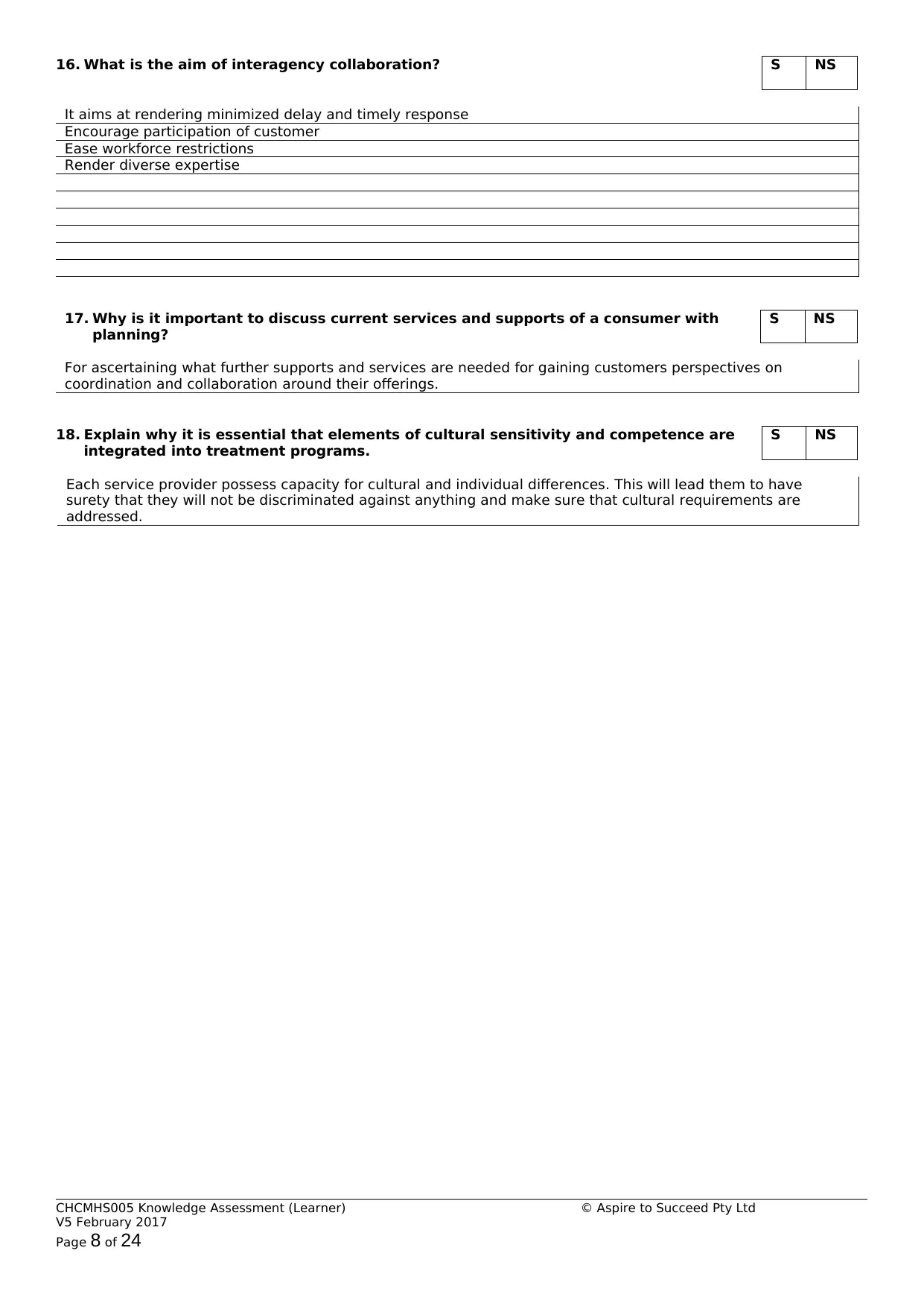
16. What is the aim of interagency collaboration? S NS
It aims at rendering minimized delay and timely response
Encourage participation of customer
Ease workforce restrictions
Render diverse expertise
17. Why is it important to discuss current services and supports of a consumer with
planning?
S NS
For ascertaining what further supports and services are needed for gaining customers perspectives on
coordination and collaboration around their offerings.
18. Explain why it is essential that elements of cultural sensitivity and competence are
integrated into treatment programs.
S NS
Each service provider possess capacity for cultural and individual differences. This will lead them to have
surety that they will not be discriminated against anything and make sure that cultural requirements are
addressed.
CHCMHS005 Knowledge Assessment (Learner) © Aspire to Succeed Pty Ltd
V5 February 2017
Page 8 of 24
It aims at rendering minimized delay and timely response
Encourage participation of customer
Ease workforce restrictions
Render diverse expertise
17. Why is it important to discuss current services and supports of a consumer with
planning?
S NS
For ascertaining what further supports and services are needed for gaining customers perspectives on
coordination and collaboration around their offerings.
18. Explain why it is essential that elements of cultural sensitivity and competence are
integrated into treatment programs.
S NS
Each service provider possess capacity for cultural and individual differences. This will lead them to have
surety that they will not be discriminated against anything and make sure that cultural requirements are
addressed.
CHCMHS005 Knowledge Assessment (Learner) © Aspire to Succeed Pty Ltd
V5 February 2017
Page 8 of 24
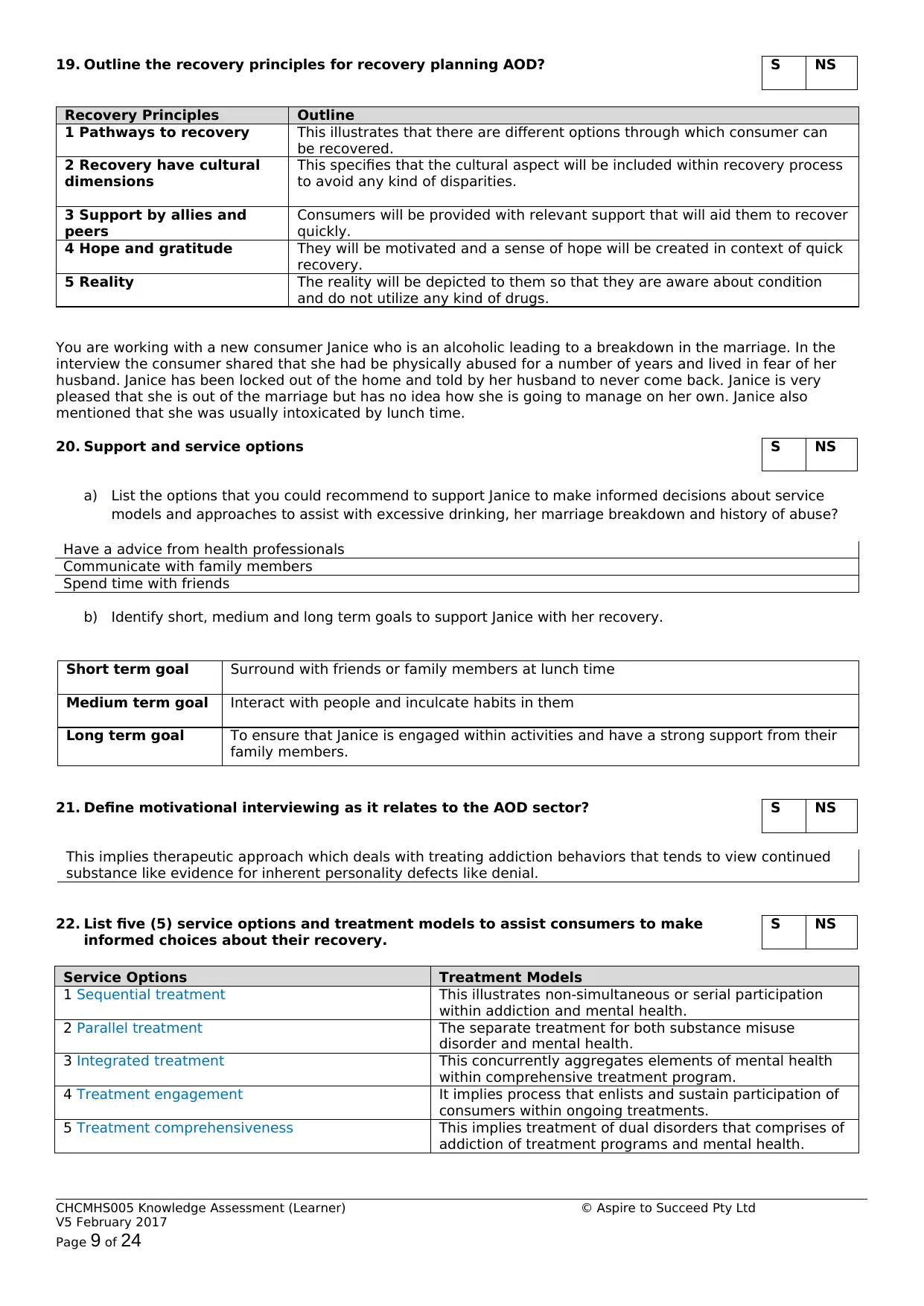
19. Outline the recovery principles for recovery planning AOD? S NS
Recovery Principles Outline
1 Pathways to recovery This illustrates that there are different options through which consumer can
be recovered.
2 Recovery have cultural
dimensions
This specifies that the cultural aspect will be included within recovery process
to avoid any kind of disparities.
3 Support by allies and
peers
Consumers will be provided with relevant support that will aid them to recover
quickly.
4 Hope and gratitude They will be motivated and a sense of hope will be created in context of quick
recovery.
5 Reality The reality will be depicted to them so that they are aware about condition
and do not utilize any kind of drugs.
You are working with a new consumer Janice who is an alcoholic leading to a breakdown in the marriage. In the
interview the consumer shared that she had be physically abused for a number of years and lived in fear of her
husband. Janice has been locked out of the home and told by her husband to never come back. Janice is very
pleased that she is out of the marriage but has no idea how she is going to manage on her own. Janice also
mentioned that she was usually intoxicated by lunch time.
20. Support and service options S NS
a) List the options that you could recommend to support Janice to make informed decisions about service
models and approaches to assist with excessive drinking, her marriage breakdown and history of abuse?
Have a advice from health professionals
Communicate with family members
Spend time with friends
b) Identify short, medium and long term goals to support Janice with her recovery.
Short term goal Surround with friends or family members at lunch time
Medium term goal Interact with people and inculcate habits in them
Long term goal To ensure that Janice is engaged within activities and have a strong support from their
family members.
21. Define motivational interviewing as it relates to the AOD sector? S NS
This implies therapeutic approach which deals with treating addiction behaviors that tends to view continued
substance like evidence for inherent personality defects like denial.
22. List five (5) service options and treatment models to assist consumers to make
informed choices about their recovery.
S NS
Service Options Treatment Models
1 Sequential treatment This illustrates non-simultaneous or serial participation
within addiction and mental health.
2 Parallel treatment The separate treatment for both substance misuse
disorder and mental health.
3 Integrated treatment This concurrently aggregates elements of mental health
within comprehensive treatment program.
4 Treatment engagement It implies process that enlists and sustain participation of
consumers within ongoing treatments.
5 Treatment comprehensiveness This implies treatment of dual disorders that comprises of
addiction of treatment programs and mental health.
CHCMHS005 Knowledge Assessment (Learner) © Aspire to Succeed Pty Ltd
V5 February 2017
Page 9 of 24
Recovery Principles Outline
1 Pathways to recovery This illustrates that there are different options through which consumer can
be recovered.
2 Recovery have cultural
dimensions
This specifies that the cultural aspect will be included within recovery process
to avoid any kind of disparities.
3 Support by allies and
peers
Consumers will be provided with relevant support that will aid them to recover
quickly.
4 Hope and gratitude They will be motivated and a sense of hope will be created in context of quick
recovery.
5 Reality The reality will be depicted to them so that they are aware about condition
and do not utilize any kind of drugs.
You are working with a new consumer Janice who is an alcoholic leading to a breakdown in the marriage. In the
interview the consumer shared that she had be physically abused for a number of years and lived in fear of her
husband. Janice has been locked out of the home and told by her husband to never come back. Janice is very
pleased that she is out of the marriage but has no idea how she is going to manage on her own. Janice also
mentioned that she was usually intoxicated by lunch time.
20. Support and service options S NS
a) List the options that you could recommend to support Janice to make informed decisions about service
models and approaches to assist with excessive drinking, her marriage breakdown and history of abuse?
Have a advice from health professionals
Communicate with family members
Spend time with friends
b) Identify short, medium and long term goals to support Janice with her recovery.
Short term goal Surround with friends or family members at lunch time
Medium term goal Interact with people and inculcate habits in them
Long term goal To ensure that Janice is engaged within activities and have a strong support from their
family members.
21. Define motivational interviewing as it relates to the AOD sector? S NS
This implies therapeutic approach which deals with treating addiction behaviors that tends to view continued
substance like evidence for inherent personality defects like denial.
22. List five (5) service options and treatment models to assist consumers to make
informed choices about their recovery.
S NS
Service Options Treatment Models
1 Sequential treatment This illustrates non-simultaneous or serial participation
within addiction and mental health.
2 Parallel treatment The separate treatment for both substance misuse
disorder and mental health.
3 Integrated treatment This concurrently aggregates elements of mental health
within comprehensive treatment program.
4 Treatment engagement It implies process that enlists and sustain participation of
consumers within ongoing treatments.
5 Treatment comprehensiveness This implies treatment of dual disorders that comprises of
addiction of treatment programs and mental health.
CHCMHS005 Knowledge Assessment (Learner) © Aspire to Succeed Pty Ltd
V5 February 2017
Page 9 of 24
⊘ This is a preview!⊘
Do you want full access?
Subscribe today to unlock all pages.

Trusted by 1+ million students worldwide

CHCMHS005 Knowledge Assessment (Learner) © Aspire to Succeed Pty Ltd
V5 February 2017
Page 10 of 24
V5 February 2017
Page 10 of 24
Paraphrase This Document
Need a fresh take? Get an instant paraphrase of this document with our AI Paraphraser
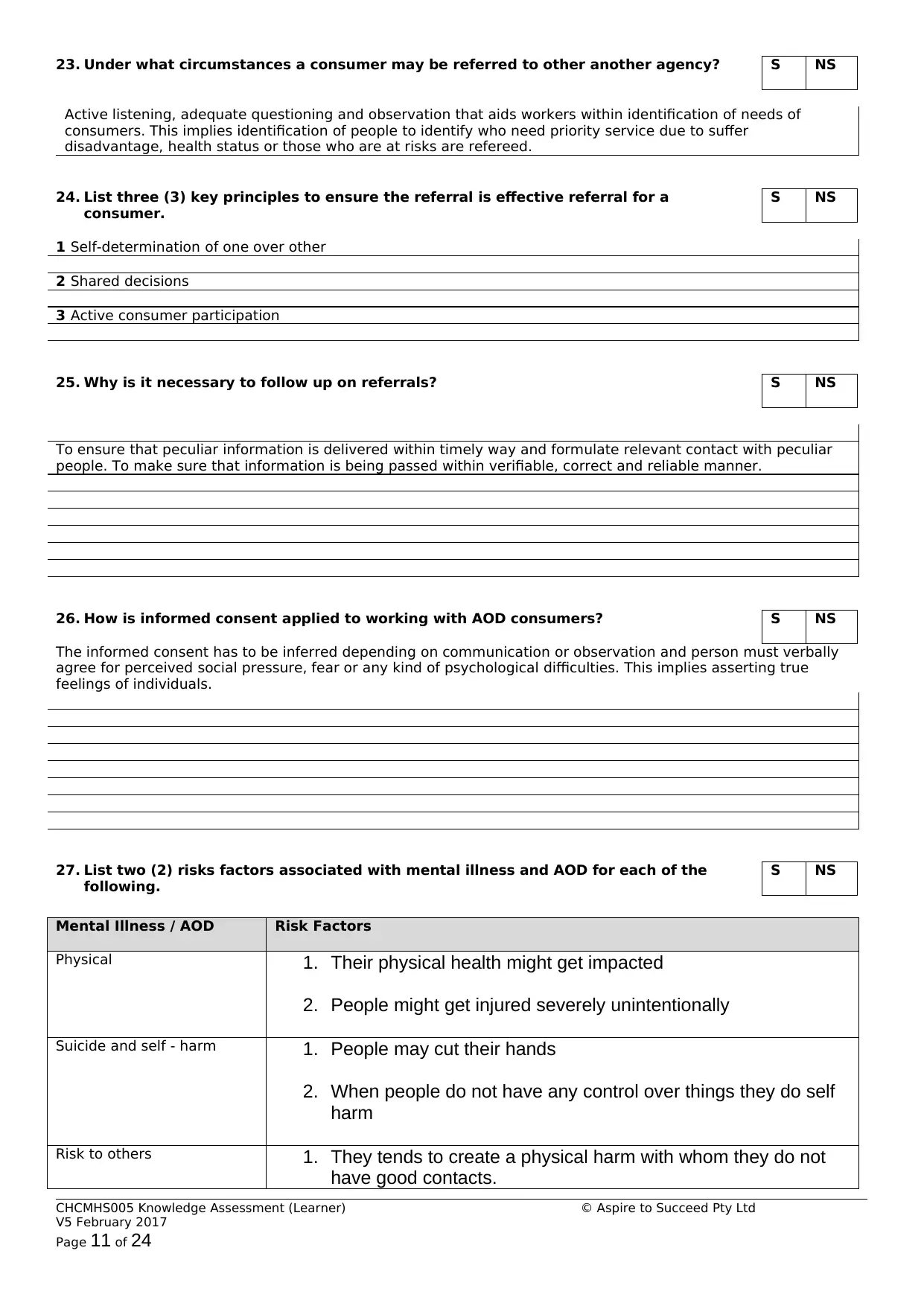
23. Under what circumstances a consumer may be referred to other another agency? S NS
Active listening, adequate questioning and observation that aids workers within identification of needs of
consumers. This implies identification of people to identify who need priority service due to suffer
disadvantage, health status or those who are at risks are refereed.
24. List three (3) key principles to ensure the referral is effective referral for a
consumer.
S NS
1 Self-determination of one over other
2 Shared decisions
3 Active consumer participation
25. Why is it necessary to follow up on referrals? S NS
To ensure that peculiar information is delivered within timely way and formulate relevant contact with peculiar
people. To make sure that information is being passed within verifiable, correct and reliable manner.
26. How is informed consent applied to working with AOD consumers? S NS
The informed consent has to be inferred depending on communication or observation and person must verbally
agree for perceived social pressure, fear or any kind of psychological difficulties. This implies asserting true
feelings of individuals.
27. List two (2) risks factors associated with mental illness and AOD for each of the
following.
S NS
Mental Illness / AOD Risk Factors
Physical 1. Their physical health might get impacted
2. People might get injured severely unintentionally
Suicide and self - harm 1. People may cut their hands
2. When people do not have any control over things they do self
harm
Risk to others 1. They tends to create a physical harm with whom they do not
have good contacts.
CHCMHS005 Knowledge Assessment (Learner) © Aspire to Succeed Pty Ltd
V5 February 2017
Page 11 of 24
Active listening, adequate questioning and observation that aids workers within identification of needs of
consumers. This implies identification of people to identify who need priority service due to suffer
disadvantage, health status or those who are at risks are refereed.
24. List three (3) key principles to ensure the referral is effective referral for a
consumer.
S NS
1 Self-determination of one over other
2 Shared decisions
3 Active consumer participation
25. Why is it necessary to follow up on referrals? S NS
To ensure that peculiar information is delivered within timely way and formulate relevant contact with peculiar
people. To make sure that information is being passed within verifiable, correct and reliable manner.
26. How is informed consent applied to working with AOD consumers? S NS
The informed consent has to be inferred depending on communication or observation and person must verbally
agree for perceived social pressure, fear or any kind of psychological difficulties. This implies asserting true
feelings of individuals.
27. List two (2) risks factors associated with mental illness and AOD for each of the
following.
S NS
Mental Illness / AOD Risk Factors
Physical 1. Their physical health might get impacted
2. People might get injured severely unintentionally
Suicide and self - harm 1. People may cut their hands
2. When people do not have any control over things they do self
harm
Risk to others 1. They tends to create a physical harm with whom they do not
have good contacts.
CHCMHS005 Knowledge Assessment (Learner) © Aspire to Succeed Pty Ltd
V5 February 2017
Page 11 of 24
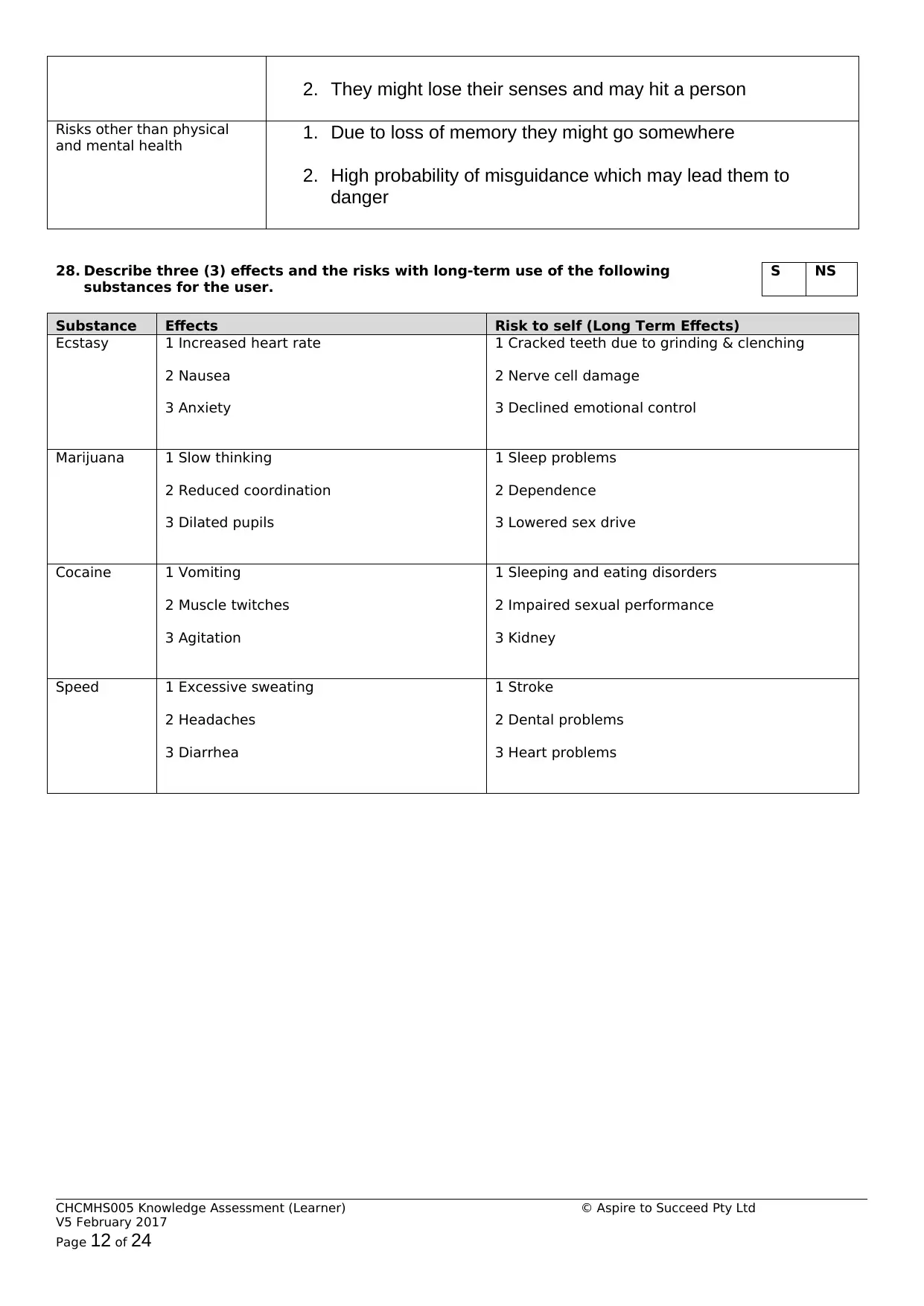
2. They might lose their senses and may hit a person
Risks other than physical
and mental health 1. Due to loss of memory they might go somewhere
2. High probability of misguidance which may lead them to
danger
28. Describe three (3) effects and the risks with long-term use of the following
substances for the user.
S NS
Substance Effects Risk to self (Long Term Effects)
Ecstasy 1 Increased heart rate
2 Nausea
3 Anxiety
1 Cracked teeth due to grinding & clenching
2 Nerve cell damage
3 Declined emotional control
Marijuana 1 Slow thinking
2 Reduced coordination
3 Dilated pupils
1 Sleep problems
2 Dependence
3 Lowered sex drive
Cocaine 1 Vomiting
2 Muscle twitches
3 Agitation
1 Sleeping and eating disorders
2 Impaired sexual performance
3 Kidney
Speed 1 Excessive sweating
2 Headaches
3 Diarrhea
1 Stroke
2 Dental problems
3 Heart problems
CHCMHS005 Knowledge Assessment (Learner) © Aspire to Succeed Pty Ltd
V5 February 2017
Page 12 of 24
Risks other than physical
and mental health 1. Due to loss of memory they might go somewhere
2. High probability of misguidance which may lead them to
danger
28. Describe three (3) effects and the risks with long-term use of the following
substances for the user.
S NS
Substance Effects Risk to self (Long Term Effects)
Ecstasy 1 Increased heart rate
2 Nausea
3 Anxiety
1 Cracked teeth due to grinding & clenching
2 Nerve cell damage
3 Declined emotional control
Marijuana 1 Slow thinking
2 Reduced coordination
3 Dilated pupils
1 Sleep problems
2 Dependence
3 Lowered sex drive
Cocaine 1 Vomiting
2 Muscle twitches
3 Agitation
1 Sleeping and eating disorders
2 Impaired sexual performance
3 Kidney
Speed 1 Excessive sweating
2 Headaches
3 Diarrhea
1 Stroke
2 Dental problems
3 Heart problems
CHCMHS005 Knowledge Assessment (Learner) © Aspire to Succeed Pty Ltd
V5 February 2017
Page 12 of 24
⊘ This is a preview!⊘
Do you want full access?
Subscribe today to unlock all pages.

Trusted by 1+ million students worldwide
1 out of 24
Related Documents
Your All-in-One AI-Powered Toolkit for Academic Success.
+13062052269
info@desklib.com
Available 24*7 on WhatsApp / Email
![[object Object]](/_next/static/media/star-bottom.7253800d.svg)
Unlock your academic potential
Copyright © 2020–2025 A2Z Services. All Rights Reserved. Developed and managed by ZUCOL.





